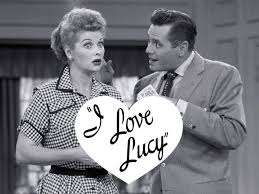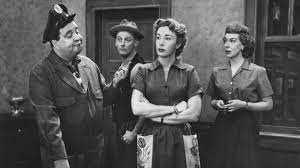The Comics
Many really great comedians showed up one way or another on television in the 50's—we saw Groucho Marx, Jack Benney, Burns & Allen, Jimmy Durante, Eddie Cantor, William Bendix, Red Skelton, Bob Hope, Red Buttons, Sid Caesar, Milton Berle, George Goebel, as well as many I'm no doubt forgetting. The primary vehicles were variety shows, quiz shows, and sitcoms. I've chosen I Love Lucy, Leave It to Beaver, and The Jackie Gleason show as representative of the type. Further nominations are welcome.
I Love Lucy
Monday nights belonged to Lucy. One could even say all of television belonged to Lucy for a few years. Originally aired from 1951 to 1957, I Love Lucy achieved an average Nielsen rating of 67.3 for the entire 1952 season, which continues to be the highest average for any single season of a tv show.
The main star of the show, Lucille Ball, came to Hollywood in the 1930's after a successful stint as a New York model. She won regular work as a result of her enthusiasm, work ethic, good looks, and willingness to do her  own stunt work, but she never rose above the level of B films. By the 40's, though, her comedic talents began to emerge, first when working in film with Red Skelton, later on radio in the My Favorite Husband series, then as co-star with Bob Hope in two very successful films in 1949 and 1950.
own stunt work, but she never rose above the level of B films. By the 40's, though, her comedic talents began to emerge, first when working in film with Red Skelton, later on radio in the My Favorite Husband series, then as co-star with Bob Hope in two very successful films in 1949 and 1950.
In 1950 CBS, which carried the My Favorite Husband series, asked Ball to take the show to television. By that point married to Cuban band leader Desi Arnaz, Lucy agreed to do the show but only if she could share the lead with her real husband. The network was reluctant to give a starring role to a Cuban, but after testing of the concept proved positive, I Love Lucy was born. And the rest, as they say, is history.
The series was pioneering in many respects: it used live audiences rather than a laugh track; it was filmed rather than recorded in kinescope; three cameras were used rather than the standard single camera; and the series gave birth to the concept of reruns when past episodes were rebroadcast to fill in when Ball gave birth to her second child and they proved ratings winners.
The Lucy Show (a later incarnation of the show) can still be seen on MeTV (in Omaha, Cox channel 123) and many full episodes are available on YouTube.
Just in case you don't remember why we used to watch the show faithfully, here's a sample clip:
The Jackie Gleason Show
 Jackie Gleason became the host of the variety show Cavalcade of Stars in 1950. He was an immediate sensation and the show was renamed the Jackie Gleason Show in 1952. It survived under a variety of names and differing formats until 1970.
Jackie Gleason became the host of the variety show Cavalcade of Stars in 1950. He was an immediate sensation and the show was renamed the Jackie Gleason Show in 1952. It survived under a variety of names and differing formats until 1970.
Gleason was a talented sketch artists and created a sizable library of characters. Among the more memorable were Reginald Van Gleason III, Joe the Bartender, Rudy the Repairman, the Poor Soul, and, most famously, blowhard Brooklyn bus driver Ralph Kramden.
Many clips both short (2 -3 minutes) and long (up to just short of 30 minutes) are available on YouTube. This is one of the shorter ones:
Leave It to Beaver
One of the very few television programs to focus on childhood and family life from the kids' point of view, Leave It to Beaver debuted to immediate popularity in 1957.
One episode from the first year ("Captain Jack") has claimed its place in television history as the first American TV show to display a toilet tank. The episode was intended to be the premier offering but it didn't clear the censor's office in time.
The writers' aim was to create humor from the situations the characters found themselves in rather than depend on jokes. According to Tony Dow (Wally Cleaver in the show), "If any line got too much of a laugh, they'd take it out. They didn't want a big laugh; they wanted chuckles."
By the start of the 1962-63 season, the show was reaching an impasse. The series was still popular with audiences, but Jerry Mathers (Beaver) wanted to retire from acting in order to attend regular high school. The show ended its network run June 20, 1963 with one of the first sitcom episodes written expressly as a season finale.
Many episodes are available on YouTube, and MeTV (Cox channel 123 in Omaha) still carries the show. YouTube has a 10-minute compilation of clips here.
This clip is typical of the humor in the show and suggests hair styling designed to shock parents is nothing new:

